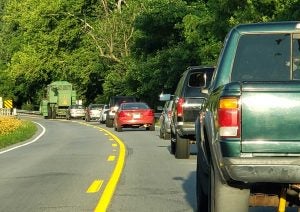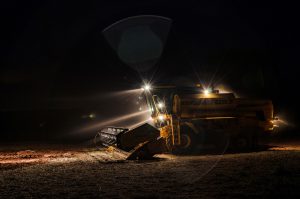It’s easy for drivers to grow impatient with you driving your combine or tractor down the road — and you with them. Just like the frustration goes both ways, so does the responsibility to make safe driving choices. The Soybean Checkoff has offered some some tips on what you can do to make it home safely this harvest season.
Safety markings
Double-check that your reflective materials and SMV signage are displayed and clean. That bright orange triangle on the back of equipment is a familiar sight and so important. It gives farmers a chance to warn the traffic around them that they are moving slowly.
Here’s a real-world scenario that puts in perspective just how quickly moving equipment down the road can become an accident: If a car going 60 miles per hour is driving toward a tractor going 20 miles per hour and is 400 feet away, how long will it take for the car to meet the tractor?
Experts at the Ohio State University Extension Agricultural Safety and Health Program say the answer is only 4.5 seconds.

The slow moving vehicle (SMV) emblem must be displayed on equipment traveling 25 mph or less, mounted base down on the rear of the vehicle. If pulling equipment, both the vehicle and the pulled equipment require an emblem displayed. When trailering equipment and traveling at speeds over 25 mph, the SMV emblem should be removed.
“We always, always make sure our slow-moving vehicle signs are clear and all our lights are working, and we try to have a pilot or chaser car follow in front of and behind us,” says Ralph Lott II, checkoff farmer-leader and New York soybean farmer.
Be visible
When you’re ready to get your day started, you pour your first cup of hot, black coffee, pull on your work boots and grab your favorite ragged ball cap — it may be hard to pause and check something else off your to-do list. But testing your lights before you hit the road, especially this time of year as the sun sets earlier, can mean the difference between a safe drive and a dangerous situation.
“One piece of advice I always share is that there’s a lot of lights on our tractors for a reason — we watch them, and so should motorists,” says Lott.
While vehicle codes vary from state to state, the U.S. Department of Transportation adopted the American Society of Agricultural and Biological Engineers Standard 279.14 for agricultural equipment, which requires tractors and self-propelled equipment to follow minimum lighting standards:
- Two white head lamps mounted at the same height and spaced as wide apart as possible on the front of the vehicle.
- Two red tail lamps mounted at the same height and spaced as wide apart as possible on the rear of the vehicle.
- Two amber flashing warning lamps visible from both front and rear, symmetrically placed and as widely spaced as possible.

Also on the checklist before hitting the road are adjusting mirrors for clear views, locking brake pedals together, and checking tires so that they are at maximum approved inflation with wheel fasteners tight.
“We run all the needed lights and flags on our equipment when we hit the road,” says Belinda Burrier, Maryland farmer-leader and soybean grower. “We don’t leave the farm without those things.”
Make sure road conditions are clear
Who hasn’t headed to work and been delayed by road maintenance closing one lane of traffic? With farm equipment often wider than the average road lane, this can cause major delays and difficulty getting to the field. Before you move farm equipment, be sure to check your route and decide if an alternate path or time of travel would be better to keep you moving.
- Check the traffic report
- Avoid road construction and maintenance
- Know the width of the roadways with fencing and guardrails
- Check for height clearance of trees and bridges, particularly if transporting equipment on a trailer
- Drive with a charged cell phone and full fuel tank, especially during inclement weather
- Check for height clearance of power lines, trees and bridges, particularly if transporting equipment on a trailer
Stay alert and don’t drive while tired
Everyone has been there. It’s harvest time. The days are shorter, you need to take one more load to the elevator or get the combine into the shed. But you’re so tired.
Harvest season means juggling many issues during long days and it is easy to be distracted and tired. The Maryland Rural Road Safety Study found distracted driving to be the leading cause of farm equipment collisions.

In addition, research conducted by the Centers for Disease Control and Prevention has shown that going too long without sleep can impair your ability to drive the same way as drinking too much alcohol does. For example, studies by the CDC have shown being awake for at least 18 hours has the same negative effects as having a blood alcohol content of 0.05 percent. Driving farm equipment or heavy machinery only adds risk.
Long hours involved in a repetitive task, such as driving a combine down a long field, can be very fatiguing, according to the National Ag Safety Database. NASD encourages farmers to rest when they are tired. Stopping for 10 to 15 minutes every two to two-and-a-half hours can help quell the drowsiness.
“Let’s all think about safety first and getting home to our families,” says Burrier.


